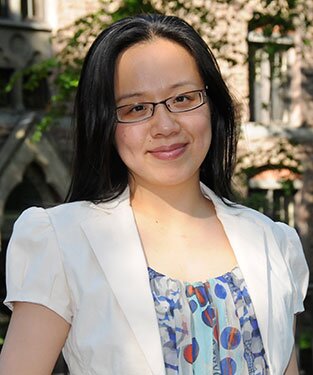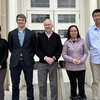
Research Interests
Research Topics
Drug Discovery, Enzymology, Genomics, Protein Structure, Protein Synthesis, Protein-Nucleic Acid Interactions, Regulation of Gene Expression, RNA Biology
Disease Research Interests
Cancer, Drug Discovery
Research Description
Announcement
We welcome highly motivated students and postdoctoral fellows in Chemistry, Biochemistry, Biophysics, Molecular Biology or related fields.
For prospective students, please apply for admission and list Prof. Jin as your faculty of interest. If you are a current UIUC student, please send your CV directly to Prof. Jin.
For postdoctoral position application, please send your CV, a brief statement of career interests, and contact information of three academic referees to Prof. Jin.
Overview
The long-term goal of the Jin laboratory is to determine the molecular basis for quality control mechanisms and regulatory processes mediated by proteins and RNAs in translation. We use a combination of state-of-the-art structural biology, and biochemical and biophysical techniques to answer fundamental questions in molecular biology. We are uniquely positioned to investigate these fundamental questions that require a combination of calculated risk-taking and a focused desire to tackle important yet underexplored areas of science. Our passion and experience in RNA research will guide us and we look forward to the challenges and opportunities in this exciting journey!
I. Molecular Mechanisms of Translational Regulation
We aim to define how regulation of translation alters critical aspects of cellular function that are essential for life. The unexpected gap between the expression of the genome at the level of transcriptome and proteome demonstrates the pervasiveness and importance of translational regulation. Regulation at the translational level not only provides a critical and fine-tuned control in gene expression, but also offers the cell an opportunity to rapidly respond to internal cellular cues and external stimuli without invoking nuclear events that involve transcription, mRNA processing and transport. We are interested in a range of regulatory mechanisms including exploring functions of the 5’-untranslated region (5’UTR), cap-independent translation and nonAUG translation. In practice, these works frequently involve creating or adopting new methodologies, analyzing data sets generated at the genomic level, and solving atomic structures of macromolecules.
II. Molecular Mechanisms of Quality Control
Cells have evolved elegant and sophisticated surveillance mechanisms to ensure protein homeostasis. The ribosome has been shown to be a central hub in sensing changing environments and regulating stress responses and gene expression. In this project, we study the molecular functions of highly conserved, developmentally regulated GTP-binding (Drg) proteins and their interactions with ribosomes and microtubules. Drg proteins are highly expressed in actively growing and developing cells, as well as reproductive adult tissues of plants, animals, and humans. Consistent with their functions in growth control, cell differentiation, and proliferation, Drg proteins are directly linked with human cancers, and developmental and neurological disorders. We discovered, for the first time, that Drg proteins alleviate translation pause and promote peptide-bond formation by stabilizing the paused ribosome in a productive conformation. We are currently investigating molecular mechanisms underpinning this important cellular process.
III. Functions of RNA-binding proteins in the post-transcriptional regulation
Thousands of proteins in the human genome contain RGG or RG repeats, and they are functionally involved in nearly every cellular pathway. Versatile, specific yet adaptable molecular interactions enabled by the unique combination of arginine and glycine, RGG motif proteins interact with a broad range of proteins and nucleic acids. More proteins containing functional RGG repeats, and their biological targets are bound to be uncovered in the future. Furthermore, post-translational modifications at the arginine in the motif extend the RGG protein’s capacity for a fine-tuned regulation. We study the properties, abundance, interactions, subcellular localization, and structures of RGG proteins in the cell. We aim to understand the mechanisms by which interactions in ordered or disordered domains, short motifs, and post-translational modification states synergistically function to control the protein functions.
Education
B. S. Central China Normal University
Ph.D. Yale University
Postdoctoral Fellow Medical Research Council - Laboratory of Molecular Biology (Cambridge, United Kingdom)
Awards and Honors
NIH Ruth L. Kirschstein National Research Service Award 2009-2012
Additional Campus Affiliations
External Links
Highlighted Publications
Our paper entitled "Structural basis of co-translational quality control by ArfA and RF2 bound to ribosome" is published online in Nature on January 11, 2017
Read the article here
http://www.nature.com/nature/journal/vaop/ncurrent/full/nature21053.html
Fuxing Zeng and Hong Jin
Peptide release promoted by methylated RF2 and ArfA in nonstop translation is achieved by an induced-fit mechanism.
RNA. 2016 Jan;22(1):49-60. doi: 10.1261/rna.053082.115. Epub 2015 Nov 9. PubMed PMID: 26554029; PubMed Central PMCID: PMC4691834.
Hong Jin, Ann C. Kelley and V. Ramakrishnan
Crystal structure of the hybrid state of ribosome in complex with the GTPase release factor 3
Proc. Natl. Acad. Sci., 108(38): 15798-15803, 2011
Hong Jin, Ann C. Kelley, David Loakes, and V. Ramakrishnan
The structure of the 70S ribosome bound to RF2 and a substrate analog provides insights into catalysis of peptide release
Proc. Natl. Acad. Sci.,, 107(19): 8593-8598, 2010
Albert Weixlbaumer*, Hong Jin*, Cajetan Neubauer, Rebecca M. Voorhees, Sabine Petry, Ann C. Kelley and V. Ramakrishnan
*These two authors contributed equally to the work
Insights into translational termination from the structure of RF2 bound to the ribosome.
Science, 322(5903): 953-956, 2008
Hong Jin, J. Patrick Loria and Peter B. Moore,
Solution structure of an rRNA substrate bound to the pseudouridylation pocket of a box H/ACA snoRNA
Mol. Cell, 26(2): 205-215, 2007
Recent Publications
Hao, Q., Liu, M., Daulatabad, S. V., Gaffari, S., Song, Y. J., Srivastava, R., Bhaskar, S., Moitra, A., Mangan, H., Tseng, E., Gilmore, R. B., Frier, S. M., Chen, X., Wang, C., Huang, S., Chamberlain, S., Jin, H., Korlach, J., McStay, B., ... Prasanth, K. V. (2024). Monoallelically expressed noncoding RNAs form nucleolar territories on NOR-containing chromosomes and regulate rRNA expression. eLife, 13, Article e80684. https://doi.org/10.7554/eLife.80684
Chowdhury, M. N., & Jin, H. (2023). The RGG motif proteins: Interactions, functions, and regulations. Wiley Interdisciplinary Reviews: RNA, 14(1), Article e1748. https://doi.org/10.1002/wrna.1748
Zeng, F., Li, X., Pires-Alves, M., Chen, X., Hawk, C. W., & Jin, H. (2021). Conserved heterodimeric GTPase Rbg1/Tma46 promotes efficient translation in eukaryotic cells. Cell Reports, 37(4), Article 109877. https://doi.org/10.1016/j.celrep.2021.109877
Brandariz-Núñez, A., Zeng, F., Ngoc Lam, Q., & Hong, J. I. N. (2018). Sbp1 modulates the translation of Pab1 mRNA in a poly(A)- and RGG-dependent manner. RNA, 24(1), 43-55. https://doi.org/10.1261/rna.062547.117
Zeng, F., & Jin, H. (2018). Conformation of methylated GGQ in the Peptidyl Transferase Center during Translation Termination. Scientific reports, 8(1), Article 2349. https://doi.org/10.1038/s41598-018-20107-8




